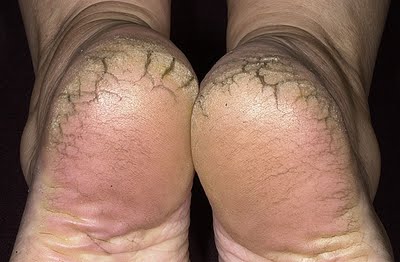Everyday, we touch, move and do many things with our hands and feet. We become productive with our hands and feet. Little as we know, they are the busiest parts of the body and often times are subjected to many harmful things in the environment. Our hands and feet also need caring and pampering. Most people would want to have flawless hands and feet despite them being subjected to many activities in our daily lives.
Dry skin does not look attractive. It can be itchy and uncomfortable to the beholder. Anyone, if given a chance, would love to transform their hands and feet into something smooth and lovely to touch. Soft, smooth skin is always attributed to young age, as in babies. Dry skin can never be attractive to touch. It ca be a major turn-off.
Thick and Thin Skin
Dry skin cause is always attributed to the overall hydration of the person. Another factor is the skin types on the hands and feet that differ from the other parts of the body. There are two skin types—the thin skin and the thick skin.
 Thick skin is found on the soles of the feet and palms of the hand and corresponding parts of the fingers and toes. It is 1 millimeter in the eyelids and 1.5 millimeter in the epidermis, or the outer lining of the skin. Thick skin has five layers of epidermis that is called,  “strataâ€, which means, “sheets.†Stratum basale is the base and deepest layer of epidermis. The second layer is the Stratum spinosum which consists of 8 to 10 layers of cells. The third layer is the Stratum granulosum, which is 3 to 5 cell layers thick. It contains keratin and granules containing a waterproofing agent. The fourth layer is called the Stratum lucidum, which consists of dead keratinocytes. The fifth and last layer is called Stratum corneum, which consists of 20 to 30 layers of flat, highly keratinized ded cells. It protects the skin from mechanical abrasion. Its cells can absorb impacts and simply flake off if necessary. It prevents pathogen entry. It functions to prevent dessication or drying out of the skin. It is also called the “cornified layerâ€. Cornification is the process by which cells in the stratum basale divide and then advance upward, becoming more and more keratinized and less alive. This makes the skin thicker.
Thick skin is found on the soles of the feet and palms of the hand and corresponding parts of the fingers and toes. It is 1 millimeter in the eyelids and 1.5 millimeter in the epidermis, or the outer lining of the skin. Thick skin has five layers of epidermis that is called,  “strataâ€, which means, “sheets.†Stratum basale is the base and deepest layer of epidermis. The second layer is the Stratum spinosum which consists of 8 to 10 layers of cells. The third layer is the Stratum granulosum, which is 3 to 5 cell layers thick. It contains keratin and granules containing a waterproofing agent. The fourth layer is called the Stratum lucidum, which consists of dead keratinocytes. The fifth and last layer is called Stratum corneum, which consists of 20 to 30 layers of flat, highly keratinized ded cells. It protects the skin from mechanical abrasion. Its cells can absorb impacts and simply flake off if necessary. It prevents pathogen entry. It functions to prevent dessication or drying out of the skin. It is also called the “cornified layerâ€. Cornification is the process by which cells in the stratum basale divide and then advance upward, becoming more and more keratinized and less alive. This makes the skin thicker.
Thin skin is found everywhere else I nthe body and contains only four layers. It does not contain the fourth layer, stratum lucidum.
What Causes Dry Skin in Hands and Feet?

All dressed up to kill. Killer heels?
Dry skin on hands and feet may occur because of friction. The skin has its own mechanism to protect itself from frequent friction. In reaction to constant friction, the layers of the skin undergo the process of cornification and doubles or triples its thickness to make the skin stronger and withstand further abuse. This becomes what we call a callous formation. However, the dry skin that has lead to callous may be very painful. Simply walking can cause soles of feet to sore and make walking a difficult task. Severe dryness can cause the skin to break and have cracks. Cracked skin when subjected to movement may cause it to bleed or further tissue damage. Cracked skin also can be itchy. Further scratching may aggravate the skin condition and may lead to another skin problem or a wound. The heels of the feet seem to be parts that are more prone to have dry skin due to wearing of shoes. The pressure brought about by the stretching of the foot every time a person steps down aggravates the dryness. Articles such as socks and hosiery aggravate the problem as certain synthetic materials dry out the skin even more. Shoes and hosiery are confining the shoes and prevents fresh air to circulate. Heat and friction and sometimes presence of fungal skin infections may further dry the skin and cause fissures. The weather and humidity also affects the condition of the skin. Prolonged hot showers or saunas as well as long exposure to highly chlorinated pool water can contribute to the cause. Eczema, diabetes, and fungal infections can also cause the dryness of the soles of the feet and adjacent parts. Foot and walking defects and allows inappropriate weight bearing on a particular part of the sole causing imbalanced pressure while walking. Examples of this are flat foot, pronation, and high arches. Obesity is also a huge factor because the heavier the individual, the more pressure and weight the feet needs to endure.

Thanks to shock absorbent shoes and sandals but still, a heavy load.
Signs and Symptoms of Dry Skin and Cracked Heels
Itchiness, feelings of skin tightness, pain, peeling or flaking, skin discoloration such as turning yellowish or brownish in color, signs of inflammation, painful soles of the feet while walking, bleeding from cracks, fungal skin infections.
Treatment and Management

A pumice stone used for callous exfoliation.
A podiatrist is a foot expert that can help you in the treatment. Exfoliating the thick callouses carefully is best done by a podiatrist. Avoid over exfoliating to prevent secondary wound abrasions. Avoiding ill fitting shoes will help prevent callous formation. A physical therapist can help and guide you in proper weight bearing, gait, and posture when standing and walking. Hand washing and proper foot hygiene can be a good preventive measure. Applying moisturizers such as lotions and petroleum jelly can help moisten and soften the affected areas.
Â
